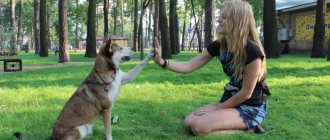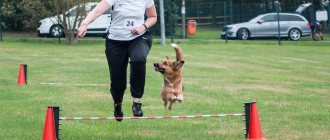Tricks or interesting commands do not belong to the general course of dog training. Professional complexes are aimed at teaching the animal basic skills. Experts know that a dog can remember up to 200-250 words from a person. In fact, dogs are capable of remembering many more words. With some effort, the owner of the animal can teach his pet many different tricks, delighting those around him with obedient behavior.
It is important to remember that in order for the dog to happily learn new interesting commands, it is necessary to create the most conducive environment for this. The trainer must be in a positive mood, and the animal must have a desire to learn something new. There should be no coercion.
Interesting commands for dogs
Performing tricks requires maximum concentration from the dog. In this regard, experts strongly recommend starting to teach your dog tricks no earlier than the animal reaches the age of 4 months. The older the animal, the harder it is to remember new information. However, there are no age restrictions.
The dog that will be trained is one that is always active and loves walking together and spending time with its owner. Dog handlers claim that there is no breed predisposition to memorize words and perform tricks. This is nothing more than a myth.
Any dog can be trained if it wishes.
Forcing an animal is contraindicated. After all, teaching interesting commands is nothing more than a game, and not basic science. Harsh pressure and punishment are not acceptable.
There are a lot of interesting tricks that you can teach your pet if you wish. Such commands could be:
- "Kiss";
- "Spin";
- "Serve";
- "Bow";
- "Snake" etc.
To obtain the maximum positive result, the dog owner must build a trusting relationship with his pet and be able to work in a team. Do not forget why a dog was brought into the house - for games, service or to be a companion.
Each dog is an individual, just like a person. Among pets, there are animals with a pronounced phlegmatic character or melancholic ones. Such dogs would rather lie at the feet of their owner than actively jump over obstacles and perform somersaults. It is necessary to take into account the wishes of your pet.
Common mistakes
The biggest mistake is being forced to perform this trick. It leads to suppression of the dog’s desire to cooperate with the owner and to a negative attitude towards the learning process.
Very often, the owner allows the dog to jump up, without restraint and even without a permission command. This leads to the fact that the animal, having heard the command “die!”, does not even try to lie down, but joyfully demands a treat.
There is no need to be upset if the pet does not want to “die” on command. Most likely, after a few weeks, the dog will be happy to learn a new trick. Animals are also not in the mood, they are affected by magnetic storms and moon phases, so you should not insist on immediate implementation. It is much more important not to lose the dog’s trust.
"Kiss"
One of the simplest tricks. To do this, you need to sit your pet in front of you and take any treat. Holding the treat in your lips, you need to lean towards the dog. It is important that your pet is on a leash. You need to step on the leash with one foot so that your pet does not make a sudden jerk. It is necessary that the dog takes the treat as carefully as possible and does not snatch it with his teeth. You need to practice the skill smoothly. In the process, you can allow the pet to paw at the owner’s chest.
To me
Another important command for guiding your dog is the “come” command. This command is extremely useful when you lose your grip on the leash or accidentally leave the front door open. Again, this command is easy to teach and will help keep your dog out of trouble.
- Put a leash on your dog.
- Get down to her level and say “Come” while gently tugging on the leash.
- When he gets to you, reward him with love and treats.
Once she has mastered this on a leash, remove the leash and continue practicing the command in a safe, enclosed area.
Spin around
To perform it, you need to take your favorite treat and use it to describe an imaginary circle in the air. You need to ensure that the dog turns around freely. Initially, you need to get the dog to spin in different directions. After several trainings, the free circle is narrowed, ensuring that the animal begins to spin in a certain zone.
"Give"
Very often this command is used in the formulation “give/give it away” . Training your dog with this command will ensure that he will let go of whatever is in his mouth. Just like the "ew" , you can prevent your dog from ingesting something that is poisonous or could cause injury. Following this command, the dog must give back the object he is holding in his teeth.
Command "Give"
"Serve" or "Bunny"
In order to teach your pet a trick, you need to sit the animal in front of you, holding it by the leash. Having taken the treat, you need to bring it to your pet’s nose and lift it vertically. Lightly tease the animal until it begins to lift its forelimbs off the ground. As soon as the dog stands on its hind legs, you need to say the command itself and give the treat. Some dogs train very well, and at the same time perfectly support their own body weight; they can sit, and some can even walk on their hind legs.
Sit
Teaching your dog to sit is one of the most basic dog commands to teach your puppy, so it's a great place to start.
A dog that knows the "Sit" command will be much calmer and easier to control than dogs that have not been taught this simple command. Additionally, the Sit command prepares your dog for tougher commands such as Stay and Come.
A dog should sit on command, of course, not on another dog, we just liked this photo
Here's how to teach your dog the "Sit" command:
- Bring the treat to your dog's nose.
- Raise your hand up, allowing his head to follow the treat and forcing the bottom of it down.
- Once she is in a sitting position, say “Sit,” give her a treat, and share some love.
Repeat this sequence several times every day until your dog masters it. Then ask your dog to sit before meals, when you go for walks, and in other situations where you want him to sit and calm down.
Bow
This is done as follows. It is not difficult to train an animal, since the position of the body for the trick is not special. Many dogs, on their own, while playing with their relatives or stretching after sleep, arch their backs and stretch their front paws in front of their muzzle. To achieve the goal, you need to step on the leash with your foot, while simultaneously moving the treat from your nose forward with your right hand. This will allow you to show the animal that it needs to lie down, while the command “Lie down!” is not given. As soon as the dog begins to stretch its limbs forward, you need to give the command “Bow”. Successful performance of a trick in the initial stages of training is considered when the dog slightly tilts its body.
General principles of animal training
Hypoallergenic cats: list of main breeds
The meaning of human words is incomprehensible to small puppies, but they are able to associate the owner’s intonations with his mood. Therefore, a puppy who makes a puddle on the floor instead of a diaper or toilet, and at the same moment receives a menacing shout from the owner, will quickly learn that he did something bad.
Praise given in a calm, soft voice and at the right time will let the baby know what to do. Accustoming to useful skills should be encouraged by stroking or favorite treats, which are given immediately after the command is executed.
Dogs gradually become accustomed to human words and gestures indicating commands. The owner and the pet must be patient and consistent. You cannot allow an animal today what was prohibited yesterday and vice versa. A grown-up dog will not be able to understand why he cannot sleep next to his owner or beg in the kitchen if he did this while he was a puppy.
The puppy is taught the command “Give me a paw”
The result of training will depend on how responsibly the owner of the animal will adhere to the principles of the command learning process:
- first a command is given, the animal carries it out, and then a quick reward follows;
- if the animal does not execute a one-time command, it cannot be repeated a second time; the dog should be forced with a leash or hand to carry out the command;
- When giving a command, you should not add accompanying words, for example, “quick voice” instead of “voice”;
- the words denoting the command must be uniform. The verbs “lie down and stand” should not replace commands included in the mandatory list for domestic dogs, such as “Lie down” and “Stand”;
- commands must be pronounced clearly, loudly, but without shouting;
- The dog needs to be trained in a calm environment and in conditions that are interesting for the pet.
Note! It is in the genes of dogs to obey the leader of the pack. It is important to make the animal realize that in the human pack it is in last place after a small child and a weak grandmother.
"Snake"
This trick is easier and better to teach dogs of medium and toy breeds. To teach this interesting command, you need to take a fairly wide step, say the command “Snake” and stick your hand with a clamped treat under your knee, while simultaneously beckoning the animal. The dog should pass under the knee diagonally. Next, take the next step, finishing the exercise. In the initial stages, 2-3 steps will be enough.
Third parties that make life easier for the owner
When the dog has become aware of its owner in the person, it can begin to be taught other commands that will significantly expand the mutual understanding between the owner and the pet.
More often, trainers use these instructions:
- "Quiet!"
After pronouncing, the dog should stop making noise.
- "Lie!"
A command similar to “Sit!” or “Place!”, but clarifying the position.
- "Car!"
The experience of thousands of trainers shows that training a dog to stop in front of cars while pronouncing a command helps to minimize the number of accidents on the road.
- "Stand!"
The dog must stop its movement and wait for further instructions.
"Back"
An interesting trick is to have the dog walk backwards. Some breeds, such as the Black Russian Terrier, are naturally able to walk this way and do not need training. If the owner of a different breed of dog wants to teach the animal the trick of backing away, it is necessary to sit the pet between the spread legs, showing the coveted treat. You need to slowly lure the dog back until it begins to back away.
Basic recommendations
When studying on your own, it is very important to follow a number of rules and avoid common mistakes. You can find the main recommendations below.
Important Rules
During training, adhere to the following rules:
- Monitor your pet's well-being. If there is the slightest sign of discomfort, the training session should be postponed to another day.
- Divide the lesson into several stages so as not to get bored with the monotony. Be sure to entertain your dog with active games if he begins to lose concentration.
- Focus on the process with your pet. Make sure you are free and will not be distracted by your phone.
- Involve all family members. The animal must follow not only your orders, but also those given by the child.
- Change direction and pace gradually and as little as possible. Otherwise, the dog will very quickly become confused and begin to boycott training.
The most important thing is patience. Don't chase quick results and try to just enjoy the process.
Important information
Barking dog
When training a dog, you need to understand: a lot depends on the breed and temperament of the pet. For example, choleric dogs (German Shepherds, Dobermans, Corgis, Chihuahuas, etc.) will voice much faster than others. Bassets, Basenjis, Akita Inu and Shiba Inu bark extremely rarely. Basenjis are generally a non-barking breed.
Rules for conducting classes
The main rule of conducting classes is the absence of long pauses. It is important to prepare each training item in advance.
Reward and Punishment
The learning process must contain motivational means. The role is to show gratitude for the work done. The maximum return is achieved in the case of quick rewards for completed actions.
It is important to use restraining methods. These include: whistles, various rattles, bunches of keys. If the intended command is not followed, the animal remains without praise (stroking, treating with treats).
An important point: taming a puppy is easier than correcting deviations in the behavior of an adult.











